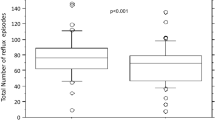Abstract
Purpose
Hypertrophic pyloric stenosis (HPS) is a common condition of infancy, often presenting with marked biochemical derangement, requiring correction. Previous studies have looked at the relationship between serum electrolytes and acid–base balance in HPS but not at the relationship between the degree of biochemical derangement and time taken to resolve the biochemical abnormality.
Methods
Retrospective analysis was performed on all 151 infants undergoing pyloromyotomy over a 3 year period. Of these, 105 met the inclusion criteria of: compliance with the unit HPS fluid protocol, and the documentation of at least three serial biochemical investigations. The rate of correction for each biochemical marker (sodium, potassium, chloride, urea, pCO2, hydrogen ion concentration, bicarbonate and the base excess) was plotted against the degree of disturbance and then against time.
Results
A significant relationship (P < 0.01) was found between the rate of correction of an abnormal chloride, urea or base excess and the degree of initial derangement. This enables the prediction of the time taken for the required correction of biochemical abnormalities prior to theatre.
Conclusion
This method of analysis may be of value in comparing the effectiveness of different fluid regimes in use for the correction of biochemical abnormalities in infants with IHPS.




Similar content being viewed by others
References
To T, Wajja A, Wales PW et al (2005) Population demographic indicators associated with incidence of pyloric stenosis. Arch Pediatr Adolesc Med 159:520–525
Rice HE, Caty MG, Glick PL (1998) Fluid therapy for the pediatric surgical patient. Pediatr Clin North Am 45:719–727
Howe CT, Lequesne LP (1964) Pyloric Stenosis: the metabolic effects. Br J Surg 51:923–932
Allan C (2006) Determinants of good outcome in pyloric stenosis. J Paediatr Child Health 42(3):86–88
Aspelund G, Langer JC (2007) Current management of hypertrophic pyloric stenosis. Sem Paediatr Surg. 16:27–33
Johnson PRV (2004) Infantile hypertrophic pyloric stenosis. Surgery 22(9):212–215
Oakley EA, Barnett PLJ (2000) Is acid base determination an accurate predictor of pyloric stenosis. J Paediatr Child Health 36(6):587–589
Shanbhogue LK, Sikdar T, Jackson M, Lloyd DA (1992) Serum electrolytes and capillary blood gases in the management of hypertrophic pyloric stenosis. Br J Surg 79(3):251–253
Miozzari HH, Tonz M, von Vigier Ro, Bianchetti MG (2001) Fluid resuscitation in infantile hypertrophic pyloric stenosis. Acta Paediatr 90:511–514
Banieghbal B (2009) Rapid correction of metabolic alkalosis in hypertrophic pyloric stenosis with intravenous cimetidine: preliminary results. Pediatr Surg Int 25:269–271
Schwartz D, Connelly NR, Manikantan P et al (2003) Hyperkalemia and pyloric stenosis. Anesth Analg 97(2):355–357
Author information
Authors and Affiliations
Corresponding author
Rights and permissions
About this article
Cite this article
Wilkinson, D.J., Chapman, R.A., Owen, A. et al. Hypertrophic pyloric stenosis: predicting the resolution of biochemical abnormalities. Pediatr Surg Int 27, 695–698 (2011). https://doi.org/10.1007/s00383-010-2813-0
Accepted:
Published:
Issue Date:
DOI: https://doi.org/10.1007/s00383-010-2813-0




